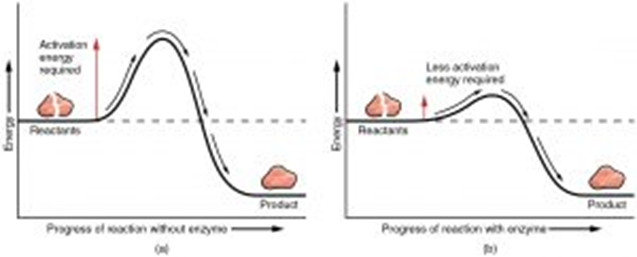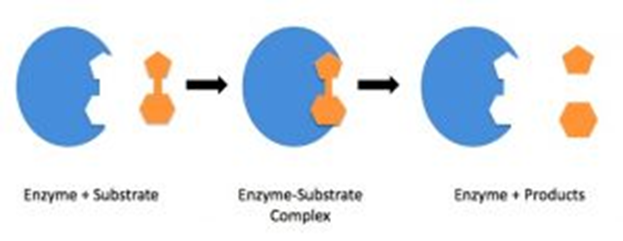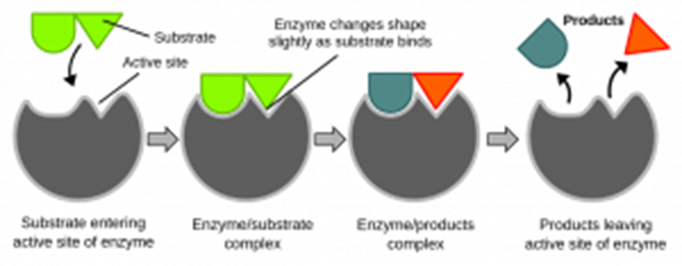Contents
Enzymes
Enzymes
What are some of the key terms you think of linked to enzymes?
- Active Site
- Protein
- Enzyme-Substrate Complex
- Biological Catalyst
Enzymes are biological catalysts made of proteins. They speed up reactions without being used up themselves. Some of the essential reactions they catalyze include respiration, photosynthesis, protein synthesis, and digestion.
Having studied the structure and function of proteins, this theory can now be applied to enzymes.
While enzymes are relatively large molecules, only a small part of the enzymes attaches to a substrate to catalyze a reaction. This site is known as the active site. The active site is specific and unique in shape due to the specific folding and bonding in the tertiary structure of the protein. Due to this specific active site, enzymes can only attach to substrates that are complementary in shape.
- What stage in protein development results in a unique 3D structure held in place by hydrogen, ionic, and disulfide bonds?
- Tertiary
- Are enzymes globular or fibrous proteins?
- Globular
Two Models of Enzyme Action
We have stated above the structure and function of enzymes, and next is to explain how enzymes speed up reactions by attaching to substrates.
All reactions require a certain amount of energy before they occur (diagram a); this is known as the activation energy. When enzymes attach to the substrate, they can lower the activation energy needed for the reaction to occur (diagram b) and therefore speed up the reaction. There are two models to explain how this occurs.
Lock and Key Model
This model suggests that the enzyme is like a lock and that the substrate is like a key that fits into it due to their complementarity in shape. This model suggests that the enzyme active site is a fixed shape and that due to random collision, the substrate can collide and attach to the enzyme. This forms an enzyme-substrate complex.
The term enzyme-substrate complex is always a marking point for enzyme questions!
Once the enzyme-substrate complex has formed, the charged groups within the active site are thought to distort the substrate and therefore lower the activation energy. The products are then released, and the enzyme active site is empty and ready to be reused.
Induced Fit Model
This model suggests that the enzyme is like a glove and the substrate is like your hand; the empty glove is not exactly complementary in shape to your hand, but when your hand enters, it enables the glove to mold around your hand to become completely complementary. This analogy describes the process well. Induced fit is when the enzyme active site is induced or slightly changes shape to mold around the substrate. When the enzyme-substrate complex occurs, due to the enzyme molding around the substrate, it puts strain on the bonds and therefore lowers the activation energy. The products are then removed, and the enzyme active site returns to its original shape.
The induced fit model is the accepted model for how enzymes function.
In summary, what is the difference between the two models?
The induced fit model suggests that the active site changes shape and then becomes complementary in shape, whereas the lock and key model suggests enzymes are a fixed shape and the active site does not change.



